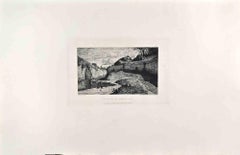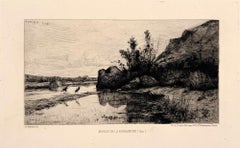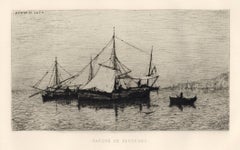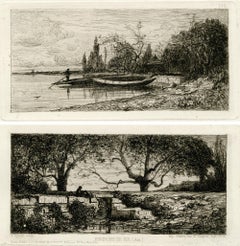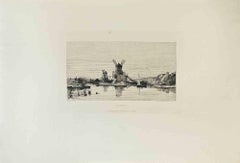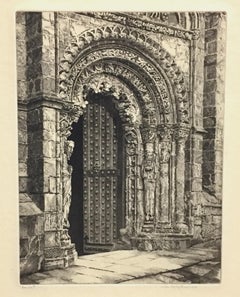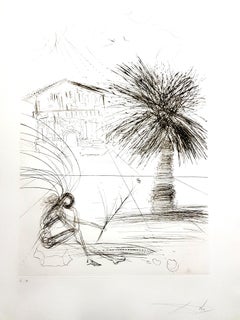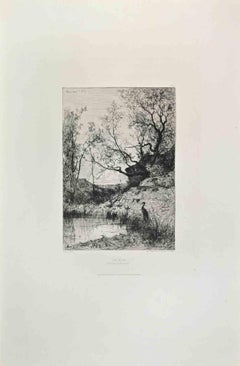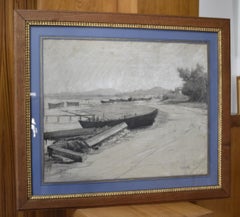Adolphe APPIAN Art
French, 1818-1898
Adolphe Appian (born as Jacques Barthelemy Adolphe Appian on 28 August 1819 in Lyon, France, died on 29 April 1898 in Lyon) was a French landscape painter and etcher. He changed his name to Adolphe Appian at age fifteen. At the same age Appian attended the Ecole des Beaux-Arts at Lyon which was an art school which specialized in training to decorate fabrics by a local silk industry. He studied under Jean-Michel Grobon and Augustin Alexandre Thierrat. Later he opened a studio in Lyon and worked as a graphic designer. He travelled to Paris to finish his studies and after he had exhibited a painting and a charcoal drawing in the Paris Salon In 1852, Adolphe Appian met Camille Corot and Charles-François Daubigny who left a lasting mark on his work and his career. He participated in the Universal Exhibition of 1862 in London. In 1866, Appian's two works that he exhibited in Paris were bought by Napoleon III and by princess Mathilde.
He painted at the beginning of his career atmospheric pictures in a monochromatic palette of the riverside of the Rhone and the south of France. In 1870 he changed his style to use brilliant and striking color in his paintings but he still continued to make charcoal drawings as well as small etchings of landscapes in the Barbizon style.
From 1863, he began to produce etchings, printed by Auguste Delâtre.
As an etcher, he had a distinct influence on the American artist, Stephen Parrish.
In 1885, he participated in the first international exhibition of white and black , section "Charcoals" and obtained the medal of honor in gold.
He won the gold medal at the 1868 Salon in Paris, and participated in the 1889 Paris Universal Exhibition .
Appian frequented the village of Rossillon , then appreciated by painters, and spent many summers in Artemare , in the Bas-Bugey , where he went down to the Hotel Buffet. He painted many sites in the Valromey . A friend of the painters of the Barbizon school, he made several stays in Fontainebleau . He is nicknamed the " Charcoal Delacroix ".
Appointed Knight of the Legion of Honor inJuly 18926 , Adolphe Appian died in Lyon in 1898.
His works a re kept in many public collections : In France
National Library of France
Municipal Museum of Bourg-en-Bresse
Castres Museum
Marseille , Cantini Museum
Museum of Fine Arts of Lyon
Nice Museum of Fine Arts
Cherbourg-Octeville , Thomas-Henry Museum
Mâcon , Musée des Ursulines
Chambery Museum of Fine Arts :
Tournus , Greuze Museum Paul-Dini Museum in Villefranche-sur-Saône Grenoble , Grenoble Museum
Rouen Museum of Fine Arts
Nantes Museum of Fine Arts
Le Puy-en-Velay , Crozatier Museum
Montpellier , Fabre Museum
In the USA San Francisco , California Palace of the Legion of Honor
Cleveland Museum of Art Dalhousie University Art Gallery ( Halifax , Nova Scotia )
Pomona College Museum of Artto
6
7
Overall Width
to
Overall Height
to
13
7
9
4
7
2
2
1
1
1
1
1
1
1
1
1
1
1
1
1
13
13
9,744
2,739
1,374
1,368
6
4
Artist: Adolphe APPIAN
Le Village de Chanaz - Etching by Appian - 1860s
By Adolphe APPIAN
Located in Roma, IT
Le Village de Chanaz is a black and White etching realized by A. Appian in the 1860s.
Titled in the lower.
Image size: 16x23.
Very good impression with wide margins and a very fr...
Category
1860s Modern Adolphe APPIAN Art
Materials
Etching
Marais de la Burbanche (Ain)
By Adolphe APPIAN
Located in Middletown, NY
Paris: Cadart, 1868.
Etching on watermarked buff laid Arches paper, 5 1/2 x 9 1/4 inches (140 x 235 mm); sheet 8 1/4 x 12 inches (210 x 305 mm), full margins. In good condition with...
Category
Mid-19th Century French School Adolphe APPIAN Art
Materials
Etching
"Barque de pecheurs" original etching
By Adolphe APPIAN
Located in Henderson, NV
Medium: original etching. This impression on cream laid paper is from the edition printed for "French Etchers", published in New York in 1884. Plate size: 6 3/8 x 9 1/8 inches (158 x...
Category
1880s Adolphe APPIAN Art
Materials
Etching
"Environs de Rix" original etching
By Adolphe APPIAN
Located in Henderson, NV
Medium: original etching. This impression on laid paper printed in 1868 for Philip Gilbert Hamerton's very scarce "Etching and Etchers". Plate size: 3 1/2 x 6 7/8 inches (88 x 175 mm...
Category
1860s Adolphe APPIAN Art
Materials
Etching
Chaland au bord d'une rivière; Environs de Rix (2); Two works
By Adolphe APPIAN
Located in Middletown, NY
TWO WORKS / Paris: Cadart, 1865.
Each an etching printed on one sheet of buff wove paper. Each impression measuring 3 1/2 x 7 inches (88 x 177 mm), full margins. With the Cadart bli...
Category
Mid-19th Century French School Adolphe APPIAN Art
Materials
Etching
Souvenir - Etching by Adolphe Appian - 1870s
By Adolphe APPIAN
Located in Roma, IT
Souvenir is a black and white etching realized by Adolphe Appian (1818–1898) in 1870s.
Titled in the lower.
Image size: 23.5cmx13cm.
Very Good condition.
Realized by Cadart for t...
Category
1870s Modern Adolphe APPIAN Art
Materials
Etching
Environs de Rix (Ain)
By Adolphe APPIAN
Located in Middletown, NY
Paris: Cadart, 1865.
Etching on buff wove paper, 3 1/2 x 7 inches (88 x 177 mm), full margins. In good condition with some light toning and several minor spots of light discoloratio...
Category
Mid-19th Century French School Adolphe APPIAN Art
Materials
Etching
"Le champ de ble" original etching
By Adolphe APPIAN
Located in Henderson, NV
Medium: original etching. Printed on chine-colle paper in Paris by Delatre and published by the Gazette des Beaux-Arts in 1863. Image size: 4 x 7 1/2 inches (100 x 190 mm). Not signed.
Category
1860s Adolphe APPIAN Art
Materials
Etching
Le Guitariste - Etching by Auguste Feyen Perrin - 1870s
By Adolphe APPIAN
Located in Roma, IT
Le Guitariste is an artwork realized by Auguste Feyen Perrin in the 1870s.
Etching.
Image size:30x20.
Good conditions.
Realized for the "Société des Aquafortistes. Born on the ...
Category
1870s Modern Adolphe APPIAN Art
Materials
Etching
L' étang neuf près de Creys - Etching by Adolphe Appian - 1870s
By Adolphe APPIAN
Located in Roma, IT
L' étang neuf près de Creys is a black and white etching realized by Adolphe Appian (1818 –1898) in 1870s.
Titled in the lower.
Image size: 26.5cmx14cm.
Very Good condition.
Sign...
Category
1870s Modern Adolphe APPIAN Art
Materials
Etching
Un Rocher dans les Communaux de Rix - Etching by Appian - 1860s
By Adolphe APPIAN
Located in Roma, IT
Un Rocher dans les Communaux de Rix is a black and White etching realized by A. Appian in the 1860s.
Titled in the lower.
Image size: 8 x 13, 8 x 12, 16 x 27
Very good impression...
Category
1860s Modern Adolphe APPIAN Art
Materials
Etching
Chemin des Roches - Etching by Appian - 1860s
By Adolphe APPIAN
Located in Roma, IT
Chemin des Roches is a black and White etching realized by Appian in the 1860s.
Titled in the lower
Image Size: 34x23
Very good impression.
Realized for the "Société des Aquafor...
Category
1860s Modern Adolphe APPIAN Art
Materials
Etching
Environs de Rix - Etching by Appian - 1870s
By Adolphe APPIAN
Located in Roma, IT
Environs de Rix is an artwork realized by A.Appian in the 1870s.
Etching.
Image size:9x17 and 9x17
Good conditions.
Realized for the "Société des Aquafortistes. Born on the ini...
Category
1870s Modern Adolphe APPIAN Art
Materials
Etching
Related Items
John Taylor Arms, Study in Stone, Cathedral of Ourense
By John Taylor Arms
Located in New York, NY
John Taylor Arms was known for making such finely drawn etchings that commercial tools were not good enough: He regularly used sewing needles with corks ...
Category
Mid-20th Century American Realist Adolphe APPIAN Art
Materials
Etching
Salvador Dali - Mission Dolores - San Francisco - Original Hand-Signed Etching
By Salvador Dalí
Located in Collonge Bellerive, Geneve, CH
Salvador Dali - Mission Dolores - San Francisco - Original Hand-Signed Etching
Title: Mission Dolores - San Francisco
Drypoint
Handsigned
Dimensions: 65 x 50 cm
Edition EA
Catalogue ...
Category
1970s Surrealist Adolphe APPIAN Art
Materials
Etching
$6,815
H 25.6 in W 19.69 in D 0.4 in
'Brooklyn Bridge' — Iconic New York City Landmark
By Luigi Kasimir
Located in Myrtle Beach, SC
Luigi Kasimir, 'Brooklyn Bridge', color etching with aquatint, 1927, edition 100. Signed in pencil.
A superb impression, with fresh colors, on heavy, cream wove paper; with margins...
Category
1920s American Modern Adolphe APPIAN Art
Materials
Etching, Aquatint
Hadrian's Mausoleum, Castel S. Angelo: A Framed 18th Century Etching by Piranesi
By Giovanni Battista Piranesi
Located in Alamo, CA
This large framed 18th century etching by Giovanni Battista Piranesi entitled "Veduta del Mausoleo d'Elio Adriana ora chiamato Castello S. Angelo nella parte opposta alla Facciata de...
Category
1750s Old Masters Adolphe APPIAN Art
Materials
Etching
$4,700 Sale Price
20% Off
H 28.88 in W 37.25 in D 1.25 in
Facing the Sun, Gyakko
By Shogo Okamoto
Located in San Francisco, CA
This artwork titled "Facing the Sun, Gyakko" is an original color aquatint by noted Japanese artist Shogo Okamoto, 1920-2001. It is hand signed, dated and numbered 62/100 in pencil b...
Category
Late 20th Century Modern Adolphe APPIAN Art
Materials
Aquatint
CONRAD MARCA-RELLI Limited ed. Etching & Aquatint American Modern, Contemporary
By Conrad Marca-Relli 1
Located in Madrid, Madrid
Conrad Marca Relli - Composition XIII
Date of creation: 1977
Medium: Etching and aquatint on Gvarro paper
Edition: 75 + AP + HC
Size: 56 x 76 cm
Condition: In very good conditions an...
Category
1970s Modern Adolphe APPIAN Art
Materials
Etching, Aquatint
$1,938
H 22.05 in W 29.93 in
Ancient Roman Architecture: Original Framed 18th C. Etching by G. Piranesi
By Giovanni Battista Piranesi
Located in Alamo, CA
"Veduta del Sepolcro della Famiglia Plauzia per la Strada Che Conduce da Roma a Tivoli vicino a Ponte Lugano" from "Le Antichità Romane" (Roman Antiquities), one of the most famous works by Piranesi. "Antichita" illustrates the tombs along the Appian Way...
Category
Early 18th Century Old Masters Adolphe APPIAN Art
Materials
Etching, Engraving, Drypoint
$3,100 Sale Price
20% Off
H 24.38 in W 31.75 in D 0.75 in
CONRAD MARCA-RELLI Limited ed. Etching & Aquatint American Modern, Contemporary
By Conrad Marca-Relli 1
Located in Madrid, Madrid
Conrad Marca-Relli - COMPOSITION IV
Date of creation: 1977
Medium: Etching and aquatint on Gvarro paper
Edition: 75 + AP + HC
Size: 56 x 76 cm
Observations: Etching and aquatint on G...
Category
1970s Abstract Adolphe APPIAN Art
Materials
Etching, Aquatint
$1,938
H 22.05 in W 29.93 in
The Gargoyle and His Quarry
By John Taylor Arms
Located in Storrs, CT
The Gargoyle and His Quarry, Notre Dame. 1920. Etching.Fletcher 90. 7 1/8 x 5 1/4 (sheet 10 1/2 x 9 1/16). Gargoyle series #1. Edition 75. A rich impression printed on 'FJHead&Co' c...
Category
1920s American Modern Adolphe APPIAN Art
Materials
Drypoint, Etching
$2,750 Sale Price
21% Off
H 7.13 in W 5.25 in D 0.5 in
Pierre-Auguste Renoir "La danse à la campagne
By Pierre Auguste Renoir
Located in Los Angeles, CA
Pierre-Auguste Renoir (French, 1841-1919)
"La danse à la campagne"
Conceived 1883
Soft ground Etching on paper
Image: 8-5/8 x 5-1/4 inches (21.9 x 13.3 cm) (plate)
Sheet size : 1...
Category
Late 18th Century Impressionist Adolphe APPIAN Art
Materials
Paper, Etching
$36,000
H 19.5 in W 15.5 in D 1.5 in
Tugs on the Hudson
By Charles Frederick William Mielatz
Located in Middletown, NY
Drypoint etching with engraving printed in black ink on Japanese mulberry paper, 4 1/2 x 3 3/8 inches (113 x 84 mm), full margins. In superb condition. A beautiful New York City river...
Category
Early 20th Century American Modern Adolphe APPIAN Art
Materials
Handmade Paper, Drypoint, Etching
"First Horse Day, 1896" - Chiyoda Palace - Japanese Woodblock by Chikanobu Yoshu
By Toyohara Chikanobu
Located in Soquel, CA
"First Horse Day, 1896" - Chiyoda Palace - Japanese Woodblock by Chikanobu Yoshu
Colorful and expressive court scne by Toyohara Chikanobu,"Yoshu" (Japanese, 1838-1912).
This is the r...
Category
1890s French School Adolphe APPIAN Art
Materials
Ink, Rice Paper, Woodcut
$875
H 15 in W 10.5 in D 0.5 in
Previously Available Items
Une Mare - Etching by Appian - 1870s
By Adolphe APPIAN
Located in Roma, IT
Une Mare is an artwork realized by Appian in the 1870s.
Etching.
Good conditions.
Realized for the "Société des Aquafortistes. Born on the initiative of the publisher Alfred Cadar...
Category
1870s Modern Adolphe APPIAN Art
Materials
Etching
Adolphe Appian (1818-1898) Les Bords de l'Ain (Shores of Ain), signed drawing
By Adolphe APPIAN
Located in Paris, FR
Adolphe Appian (1818-1898)
Les Bords de l'Ain (Shores of Ain),
signed lower left
charcoal and white chalk on paper
36 x 45 cm
In quite good condition : foxings in the upper part (...
Category
1860s Impressionist Adolphe APPIAN Art
Materials
Charcoal
Adolphe Appian art for sale on 1stDibs.
Find a wide variety of authentic Adolphe APPIAN art available for sale on 1stDibs. You can also browse by medium to find art by Adolphe APPIAN in etching, charcoal, oil paint and more. Much of the original work by this artist or collective was created during the 19th century and is mostly associated with the Impressionist style. Not every interior allows for large Adolphe APPIAN art, so small editions measuring 7 inches across are available. Customers who are interested in this artist might also find the work of Achille-Émile Othon Friesz, Robert Combas, and Albert Besnard. Adolphe APPIAN art prices can differ depending upon medium, time period and other attributes. On 1stDibs, the price for these items starts at $150 and tops out at $1,086, while the average work can sell for $250.
